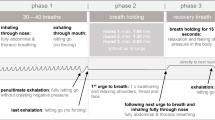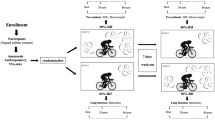Abstract
The effects of negative air-ions on human physical performance has been investigated. Twenty-one healthy males, 20–25 years old (X=23.6±2.6) were exposed to two 180-min rest and exercise sessions two weeks apart. The subjects were randomly assigned into either an experimental group (n=12) or to a control group (n=9). The experimental group performed the first session in neutral air conditions and the second one in air containing 1.36 to 1.90×105 negative air ions and 1.40 to 1.66×102 positive air ions/ml. The control group performed both sessions under neutral air conditions. All sessions were held at Ta=40±1‡C and 25±5% RH. Each session included one hour of resting under the respective ionization conditions, followed by 3 30-min cycle ergometer work bouts, separated by 7-min rest periods. The mechanical work-load during the bicycle exercise was 1.64±0.6 W/kg BW. The experimental group showed a significant reduction with negative air-ions in heart rate (HR), in rectal temperature, and in the rating of perceived exertion (RPE), all when compared with their own neutral session. The control group showed no significant changes between the first and the second exposure. Although not statistically significant, being exposed to negative air-ions seems also to reduce total sweat rate and minute ventilation (VE), and to increase O2 pulse. It is suggested that under the conditions of this study negative air ions canimprove various cardiovascular and thermoregulatory functions as well as subjective feelings during physical effort. It is felt that such positive influences may be augmented by increasing the exposure time to negative ionized air and/or prolonging the stressful conditions.
Similar content being viewed by others
References
ALBRECHTSEN, O., CLAUSEN, V., CHRISTENSEN, F. G., JENSEN, J. O. and MØLLER, T. (1968): The influence of small ions on human well-being and mental performance. Int. J. Biometeor., 22: 249–262.
ASANO, K. (1972): The influence of hypoxia and exercise on ascorbic acid metabolism. Japan. J. Physical Fitness and Sport Med., 21: 69–86.
BACHMAN, C. H., McDONALD, R. D. and LORENZ, P. J. (1966): Some effects of air ions on rats. Int. J. Biometeor., 10: 39–46.
BAR-OR, O., LUNDEGREN, H. M., MAGNUSSON, L. I. and BUSKIRK, E. R. (1968): Distribution of heat-activated sweat glands in obese and lean men and women. Human Biol. 2: 235–248.
BAR-OR, O. and INBAR, O. (1977): Relationship between perceptual and physiological changes during heat acclimatization in 8–10 year old boys. In: Frontiers of Activity and Child Health. R. J. Shephard and H. Lavalée (ed.), Pelican, Quebec, 205–214.
BORG, G. (1962): Physical Performance and Perceived Exertion. Gleerup, Lund.
CADARIU, G., IONESCU, A. and PETRANU, D. (1972): Fluenta aeroionizarii asupra capacitatii de munca. Fiziol. Normala Patolog., 18: 461–468.
DELEANU, M. and MOZES-LöRINCZ, M. (1975): Effect of negative air ion exposure on adaptation to physical effort in young sportsmen. In: Biometeorology 6, Part I. H. E. Landsberg and S. W. Tromp (ed.), Int. J. Biometeor. Supplement vol. 19: 131.
DEVERENCO, P. (1977): Action of unipolar ionized air in rat during experimental muscular exercise. Med. Term. E Climatol. 34: 45–50.
DEVRIES, H. A. and CORLE, E. K. (1965): Ergometric effects of breathing ionized air. J. Sports Med. Phys. Fitness, 5: 7–12.
GREENLEAF, J. E. (1979): Hyperthermia and exercise. In: International Review of Physiology Environmental Physiology III, Vol. 20. D. Robertshow (ed.), University Park Press, Baltimore, 157–208.
HANSELL, C. W. (1962): An attempt to define ionization of the air. Proc. of the Int. Conf. on Ionization of the Air, American Institute of Climatology, Franklin Inst, Philadelphia, Pennsylvania, January 2–10.
HOOGERWERF, A. and HOITINK, A. W. J. H. (1963): The influence of vitamin C administration on the mechanical efficiency of the human organism. Int. Z. angew. Physiol., 20: 64–72.
INBAR, O. (1978): Acclimatization to dry and hot environment in young adults and children 8–10 years old. Doctoral Dissertation, Columbia University, New York.
KRUEGER, A. P., SMITH, R. F. and MILLER, J. W. (1959): Effects of air ions on the trachea of primates. Proc. Soc. exp. Biol. (N. Y.), 101: 506–507.
KRUEGER, A. P. and SMITH, R. F. (1960): The biological mechanisms of air ion action II, negative ion effects on the concentration and metabolism of 5HT in the mammalian respiratory tract. J. gen. Physiol., 44: 269–276.
KRUEGER, A. P., ANDRIESE, O. C. and KOTAKA, S. (1963): The biological mechanism of air ion action. Int. J. Biometeor., 7: 3–16.
KRUEGER, A. P. and REED, E. J. (1976): Biological impact of small air ions. Science, 193: 1209–1213.
MINH, A. A. (1963): Ionisatsia vosducka i ee ghighienitcheskow snatchenie. Gos. Isd. Med. Lit., 2nd Ed., Moscow.
OLIVEREAU, J. M. (1975): Incidences de L'aéro-ionisation sur les glandes endocrines, le système et le comportement. In: Problèmes d'ionisation et d'aéroionisation. G. R. Rager (ed.), Maloine S. A., Paris, 136–150.
PIRANI, L. L. (1952): Relation of vitamin C to adrenocortical function and stress phenomena. Metab., Clin. Exp., 1: 97–122.
RAMANATHAN, N. L. (1964): A new weighting system for mean surface temperature of the human body. J. appl. Physiol. 19: 531–533.
SIGEL, S. S. R. G. (1979): Bio-psychological influences of air ions in men: effects on 5-hydroxytryptamine and mood. In: Biometeorology 7, Part 1, Z. Zemel and N. St. G. Hyslop (ed.), Int. J. Biometeor. Supplement vol. 24: 119.
SKINNER, J. S., HUSTLER, R., BERGSTEINOVA, V. and BUSKIRK, E. R. (1973): Perception of effort during different types of exercise and under different environmental conditions. Med. Sci. Sports, 5: 110–115.
SOVIJARVI, A. R. A., ROSSET, S. HYVARINEN, J., FRANSSILA, A., GRAEFFE, G. and LEHTIMAKI, M. (1979): Effect of air ionization on heart rate and perceived exertion during a bicyle exercise test. A double-blind cross-over study. Eur. J. appl. Physiol., 41: 285–291.
STRYDOM, N. B., KOTZE, H. F., VANDERWALT, W. H. and ROGERS, G. G. (1976): Effects of ascorbic acid on rate of heat acclimatization. J. appl. Physiol., 41: 202–205.
SULMAN, F. G., DANON, A., PFEIFER, Y., TAL, E. and WELLER, C. P. (1970): Urinalysis of patients suffering from climatic heat stress. Int. J. Biometeor., 16: 45–53.
SULMAN, F. G., LEVY, D., LEWY, A. and PFEIFER, Y. (1975): Ionometry of hot dry desert winds (Hamsin, Sharav) and application of ionising treatment to weather sensitive patients. Int. J. Biometeor., 18: 313–318.
SULMAN, F. G., LEVY, D., PFEIFER, Y., SUPERSTINE and TAL, E. (1976): Sensitivity to hot-dry Sirocco winds and its treatment by air ionisation. La Clinica Termale, 29: 1–15.
SULMAN, F. G., LEVY, D., PFEIFER, Y. and TAL, E. (1980): Human reaction to climate fluctuations of air electricity. In: Biometeorology 7, Part 1. Z. Zemel and N. St. G. Hyslop (ed.), Int. J. Biometeor. Supplement Vol. 24: 120.
Author information
Authors and Affiliations
Additional information
With the technical assistance of M. Sheinovitz.
Rights and permissions
About this article
Cite this article
Inbar, O., Rotstein, A., Dlin, R. et al. The effects of negative air ions on various physiological functions during work in a hot environment. Int J Biometeorol 26, 153–163 (1982). https://doi.org/10.1007/BF02184628
Received:
Issue Date:
DOI: https://doi.org/10.1007/BF02184628




